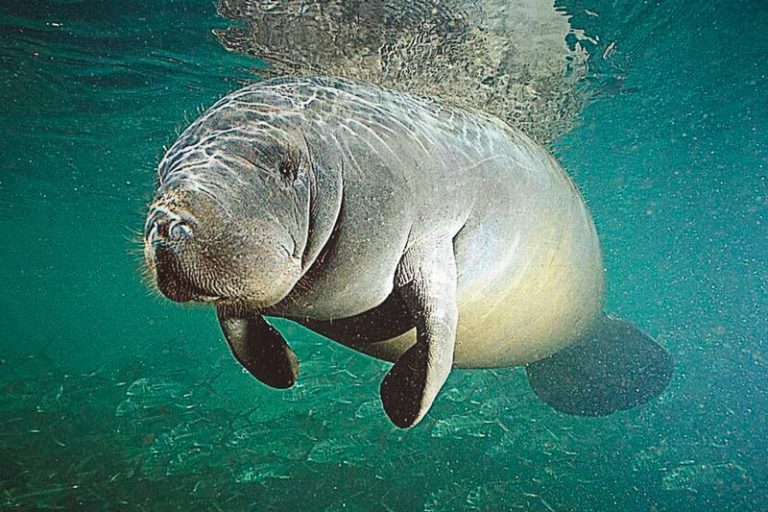The rapid extinction of seagrasses is causing the malnutrition and unprecedented mortality of the Florida manatee, a marine mammal that has represented the state since 1975 and contributes to the multi-billion dollar wildlife industry of this tourist peninsula in the United States.
Lack of food has contributed to the death of 432 manatees between January 1 and March 5, more than half of the 824 that died during all of 2018, so far the worst year for this herbivore, according to the Commission of Florida Fish and Wildlife Conservation (FWC).
The alarm is great, so much so that Congressman Charlie Crist this week asked the federal government to activate an emergency measure that will facilitate resources and investigation into the causes of the death.
“Our majestic manatees in Florida are dying at a terrible rate,” lamented the Democrat, noting that according to preliminary studies, “starvation” is the main cause.
The Save the Manatee Club group, in central Florida, the region that accumulates the highest number of deaths, warned that globally “every thirty minutes a seagrass meadow the size of a football field is lost.”
Early studies indicate that “most” of these deaths in the Florida manatee, a subspecies of the West Indian (Trichechus manatus), is occurring in the Indian River lagoon in the center of the state.
LACK OF RESOURCES FOR RESCUE
“It is clear that many of these manatees, especially in the Indian River, are dying due to malnutrition or hunger aggravated by cold stress,” biologist Patrick Rose, director of Save the Manatee Club, told EFE.
He clarified, however, that due to limited resources and lack of personnel due to covid-19, not all corpses have been subjected to autopsies or have been able to be analyzed by the FWC “to determine with certainty the cause of death.”
According to Rose, for many decades, the lagoon has been subjected to excessive human-made nutrient pollution, “leading to a series of harmful algal blooms over the last decade, causing massive losses (about 50,000 acres) in the cover of seagrass and other forage foods for manatees.”
For Congressman Crist, the situation “will only get worse if climate change continues.”
In addition to starvation, these tireless grass eaters are dying of cold, loss of habitat, and in boating accidents.
This week a video went viral in which a manatee ate in one of the Miami Beach canals the little grass accumulated under a boat and also spiced with plastic waste.
ALARMING EXTINGUISHING OF SEA GRASSES
In addition to feeding manatees, Florida’s seagrass beds are vital ecosystems, providing food, habitat, and nursery grounds for numerous species, shellfish, and sea turtles.
The Florida manatee lives in the coastal waters, rivers and springs of the state, and during the warm months in the north some travel to other states.
Before the colder months they return to Florida, a key state for their survival, where they feed on a variety of submerged and floating plants in fresh or marine waters.
Save the Manatee Club explained that manatees consume the seven species of seagrasses in the state, which “are disappearing at an alarming rate” due to nitrogen and phosphorus runoff from homes, farms and industries.
These nutrients, in addition to muddying the water, favor the rapid growth of algae, which can block sunlight and cause the death of a large area of seagrass, the organization detailed.
Ship propellers, frost and hurricanes are also contributing to the extinction of seagrass, by piercing sediments, removing the root plant and blocking the sun’s rays that facilitate its growth with sedimentation.
The so-called “sea cows”, which can consume 4 to 9% of their body weight daily, usually spend up to eight hours a day eating aquatic vegetation.
IT IS URGENT TO INVESTIGATE THE CAUSES
Congressman Crist, who has joined calls to “save the manatee,” asked to investigate the causes of the manatees’ deaths. Last year more than 600 died.
He said that this mammal contributes to “the 5 billion dollars” of the tourism industry associated with wildlife in the state, which designated it in 1975 as the “marine mammal of Florida.”
The Democrat urged federal authorities to declare the situation an “Unusual Death Event (UME),” which “will allow additional resources to be used to investigate the cause and take steps to prevent further damage.”
Rose said the priority now is the rescue and rehabilitation of sick and injured manatees (they have 50 so far), but noted that they need resources and urged the Florida Congress and the US Fish and Wildlife Service (USFWS). ) to provide the required financial support.
He also explained that restoring the Indian River lagoon and recovering the species will be “a long-term effort that will require firm commitments from a number of partner agencies and organizations over many years.”
Congressman Crist urged in a letter to the USFWS “to determine if additional protections are warranted” for this animal after the administration of President Donald Trump (2017-2021) lowered the manatee’s protection status from “Endangered” to “in 2017.” Threatened ».
“Each day that passes with an increase in deaths brings us one step closer to an unthinkable turning point,” said the Florida politician.

